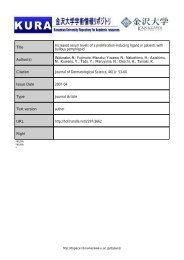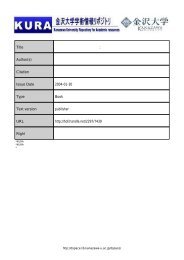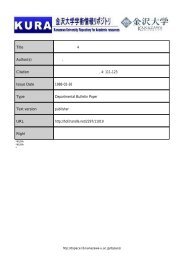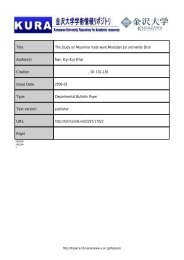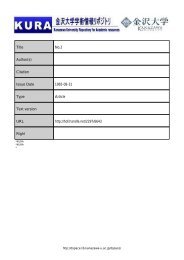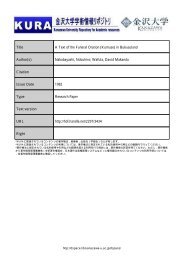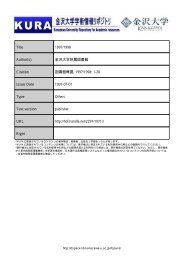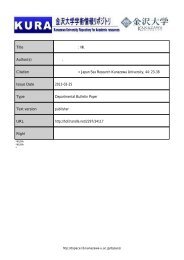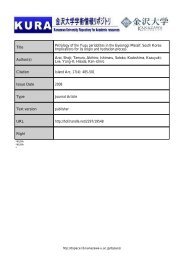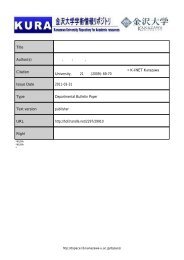Title Petrological feature of spinel lherzolite xenolith from Oki-Dogo ...
Title Petrological feature of spinel lherzolite xenolith from Oki-Dogo ...
Title Petrological feature of spinel lherzolite xenolith from Oki-Dogo ...
Create successful ePaper yourself
Turn your PDF publications into a flip-book with our unique Google optimized e-Paper software.
<strong>Oki</strong>-<strong>Dogo</strong> Island <strong>spinel</strong> <strong>lherzolite</strong> <strong>xenolith</strong> 229<br />
metasomatic melt and/or fluid impregnations. This<br />
LREE-enrichment metasomatism is relevant to<br />
Fe-rich cumulus ultramafic rock formation in the<br />
upper mantle beneath the <strong>Oki</strong>-<strong>Dogo</strong>, but is apparently<br />
irrelevant in Kurose mantle.<br />
THE JAPAN SEA OPENING<br />
Taking the location and the eruption age (Pliocene)<br />
<strong>of</strong> the alkaline basalts with the mantle <strong>xenolith</strong>s<br />
into account, the upper mantle beneath the <strong>Oki</strong>-<br />
<strong>Dogo</strong> Island is a possible mantle residue formed<br />
during the opening <strong>of</strong> the Japan Sea in the middle<br />
<strong>of</strong> the Tertiary. In plagioclase-free <strong>spinel</strong> peridotite<br />
samples <strong>from</strong> oceanic and continental areas, the<br />
composition <strong>of</strong> <strong>spinel</strong> varies systematically as a<br />
function <strong>of</strong> the degree <strong>of</strong> bulk rock major element<br />
depletion and, thus, the <strong>spinel</strong> Cr# is commonly<br />
considered to be a good indicator <strong>of</strong> the degree <strong>of</strong><br />
melting (Dick & Bullen 1984). Melting experiments<br />
<strong>of</strong> peridotitic material have shown a trend <strong>of</strong><br />
increasing <strong>spinel</strong> Cr# <strong>of</strong> the residual peridotite<br />
with increasing proportions <strong>of</strong> coexisting melt<br />
(Jaques & Green 1980). Arai (1994b) suggested<br />
therefore, by using the olivine–<strong>spinel</strong> chemical<br />
relation in volcanics, that the source peridotite for<br />
the back-arc-basin basalt had experienced extraction<br />
<strong>of</strong> high-degree partial melt including high-<br />
Cr# <strong>of</strong> <strong>spinel</strong> (0.4–0.5). In fact, we obtained the<br />
depleted mantle peridotites <strong>from</strong> the following two<br />
localities in the northern part <strong>of</strong> the Japan Sea.<br />
One is the harzburgite <strong>xenolith</strong> (Cr# <strong>of</strong><br />
<strong>spinel</strong> = 0.5) <strong>from</strong> Oshima-Oshima, which is<br />
included in calc-alkaline andesite (Ninomiya &<br />
Arai 1992), and the other is also the harzburgite<br />
<strong>xenolith</strong> (Cr# <strong>of</strong> <strong>spinel</strong> = 0.45) found in alkaline<br />
basalt by the abyssal dredging in the Japan Sea<br />
(38∞12.2¢N, 132∞34.7¢E; Ishii 1987). The Cr# <strong>of</strong><br />
<strong>spinel</strong> is, however, much lower in <strong>Oki</strong>-<strong>Dogo</strong> <strong>spinel</strong><br />
<strong>lherzolite</strong> (0.06–0.26) than in those harzburgites<br />
(Fig. 5). Even though we discussed in the former<br />
section the possibility <strong>of</strong> Al-enrichment during Femetasomatism<br />
in the mantle beneath the <strong>Oki</strong>-<br />
<strong>Dogo</strong> Island, it is unlikely that the <strong>spinel</strong> <strong>lherzolite</strong><br />
was originally harzburgite representative <strong>of</strong> the<br />
Japan arc mantle.<br />
In contrast, Hirai (1986) concluded that the<br />
upper mantle peridotite <strong>xenolith</strong> <strong>from</strong> Kurose is<br />
the residue after back-arc-basin basalt formation<br />
beneath the Japan Sea. The Kurose peridotites<br />
have higher Cr# <strong>of</strong> <strong>spinel</strong> (0.27–0.55) than the <strong>Oki</strong>-<br />
<strong>Dogo</strong> <strong>spinel</strong> <strong>lherzolite</strong>. The Cr# <strong>of</strong> <strong>spinel</strong> is, however,<br />
lower in most Kurose peridotites (approx.<br />
0.3) than in harzburgites <strong>from</strong> the Japan Sea floor<br />
and <strong>from</strong> Oshima-Oshima. Tamaki et al. (1992)<br />
considered that the northern part <strong>of</strong> the Japan Sea<br />
was formed by the sea-floor spreading with volcanism,<br />
while crustal thinning was the main mechanism<br />
for the southern part, as determined during<br />
two cruises <strong>of</strong> the Ocean Drilling Program on the<br />
Japan Sea (Leg 127 & 128). In other words, the<br />
degree <strong>of</strong> melting in the upper mantle beneath<br />
the northern part <strong>of</strong> the Japan Sea is higher than<br />
in that beneath the southern part. The variation <strong>of</strong><br />
<strong>spinel</strong> Cr# in the mantle peridotites <strong>from</strong> the<br />
Japan Sea and the coast supports this estimation<br />
<strong>of</strong> melting degree in the upper mantle.<br />
CONCLUSIONS<br />
The <strong>spinel</strong> <strong>lherzolite</strong> <strong>xenolith</strong>s <strong>from</strong> <strong>Oki</strong>-<strong>Dogo</strong><br />
Island are slightly more Fe-rich than other mantle<br />
peridotite <strong>xenolith</strong>s in the world. Their microtexture,<br />
modal compositions and the high NiO content<br />
in olivine, suggest that they are Cr-diopside series<br />
residual mantle peridotite. The low Mg# <strong>of</strong> their<br />
silicate minerals was affected by the formation <strong>of</strong><br />
abundant Fe-rich cumulative ultramafic rocks<br />
found as <strong>xenolith</strong>s in the same lava flow.<br />
The clinopyroxene has LREE-enriched U-<br />
shaped patterns. These patterns can be formed by<br />
REE-enrichment metasomatism after depletion<br />
by melt extraction. The metasomatic agent was<br />
released <strong>from</strong> the melt that had precipitated<br />
Fe-rich ultramafic rocks into the upper mantle<br />
peridotite.<br />
A similar REE-pattern is found in Kurose peridotite<br />
<strong>xenolith</strong>s, despite their rare association with<br />
Fe-rich ultramafic <strong>xenolith</strong>s. The similarity <strong>of</strong><br />
REE patterns between <strong>Oki</strong>-<strong>Dogo</strong> and Kurose and<br />
the disparities in the volume <strong>of</strong> Fe-rich <strong>xenolith</strong>s<br />
and the Mg# are due to the large difference <strong>of</strong> the<br />
diffusion rate and the mobility between major and<br />
trace elements.<br />
Mantle peridotite <strong>xenolith</strong>s <strong>from</strong> <strong>Oki</strong>-<strong>Dogo</strong> and<br />
Kurose are the residue after the opening <strong>of</strong> the<br />
Japan Sea, although they show a relatively low<br />
degree <strong>of</strong> partial melting. This is consistent with<br />
the tectonic model <strong>of</strong> the opening <strong>of</strong> the Japan Sea.<br />
ACKNOWLEDGEMENTS<br />
We are very grateful to E. Takahashi for his guidance,<br />
discussion and encouragement and for giving<br />
us the opportunity <strong>of</strong> studying <strong>Oki</strong>-<strong>Dogo</strong> ultrama-




